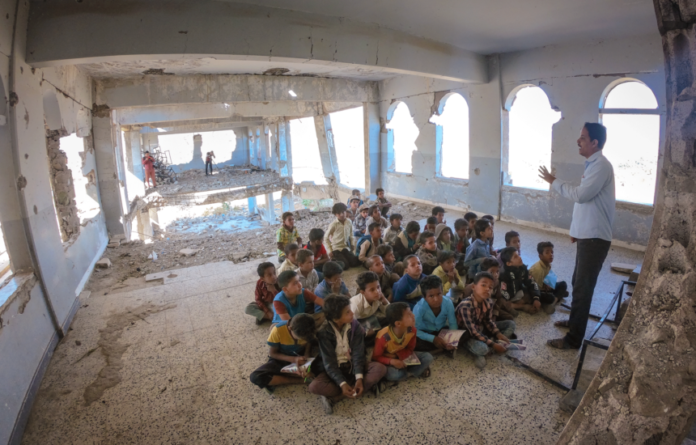The Importance of Education in Conflict Zones
Education serves as a crucial foundation for the development of individuals and societies, particularly in conflict-affected areas. It empowers children with knowledge and skills, enabling them to better navigate the complexities of life in challenging environments. In conflict zones, where violence and instability prevail, access to education can significantly contribute to community stability and resilience, acting as a buffer against the chaos surrounding them.
Children in these regions often face profound challenges that disrupt their education. Armed conflict can lead to the destruction of schools, displacement of families, and a scarcity of qualified educators. This disruption in the learning process deprives children of the opportunity to achieve their potential and creates a cycle of disadvantage that can last for generations. Furthermore, many children experience trauma due to exposure to violence, which can severely impact their ability to focus, learn, and thrive academically.
In addition, the psychological effects of violence can hinder personal development and social integration. When children are unable to attend school or face perilous conditions while learning, their overall well-being and mental health can suffer. Education, therefore, is not just about academic achievement; it also plays a vital role in fostering social cohesion, building trust, and promoting peace within these communities. By providing a safe space for children amid turmoil, educational institutions can help mitigate some of the insecurities they face in conflict zones.
Thus, ensuring access to quality education in these areas is paramount. It is essential not only for the individual growth of children but also for the long-term prospects of peace and stability in regions affected by conflict. Education can ultimately serve as a powerful tool for healing and reconciling communities torn apart by violence, helping those affected to envision a better future.
Rising Violence Against Schools: Statistics and Realities
The alarming trend of increasing violence against educational institutions has become a pressing global issue, with recent statistics revealing a staggering 44 percent increase in attacks on schools over the past year. This escalation in violence has far-reaching implications for students, teachers, and the broader community. According to reports, thousands of educational facilities have been targeted, resulting in widespread disruption to learning environments and significant emotional distress.
In examining the impact of these attacks, it is essential to consider the affected demographics. Current estimates indicate that hundreds of thousands of students have experienced direct violence or witnessed attacks on their schools. This exposure not only disrupts their education but also leads to devastating mental health repercussions, including anxiety, depression, and post-traumatic stress disorder. Furthermore, tens of thousands of teachers and education staff have faced threats, injuries, or fatalities as a result of these incidents, compounding the educational crisis.
The tragic outcomes of these violent acts are numerous and concerning. Reports of abduction, death, and severe injuries highlight the urgent need for intervention and protective measures. Many victims are not only harmed physically but also mentally scarred, leading to a generation of children unable to engage in learning effectively. The degree of trauma suffered by these students often manifests in a reluctance to return to school, undermining future opportunities for education and development.
This escalating violence against schools is more than a statistic; it represents a humanitarian crisis that demands immediate attention and action. The urgency of the situation calls for collaboration between governments, international organizations, and local communities to prioritize the safety of educational environments and safeguard the right to education for all children. Only through concerted efforts can we hope to reverse this alarming trend and protect the sanctity of our schools.
The Global Response: Initiatives by the United Nations and Beyond
In recent years, the alarming rise in violence against education has prompted robust responses from the international community, particularly through the United Nations (UN) and various organizations dedicated to safeguarding the right to education. The UN has initiated a multitude of programs aimed at protecting schools and promoting safe learning environments for children globally. These initiatives emphasize the need for comprehensive strategies that address the root causes of violence and ensure the safety of educational institutions.
One of the most significant frameworks established in this respect is the Safe Schools Declaration, which seeks to commit countries to protect educational facilities and ensure the continuity of education in conflict zones. The declaration calls for the implementation of Guidelines for Protecting Schools and Universities from Military Use during Armed Conflict, which is instrumental in mitigating risks and fostering a secure environment for students and educators. This collective commitment encourages nations to actively participate in preserving access to education, even amidst turmoil.
Furthermore, various UN agencies, such as UNICEF and UNESCO, are pressing for enhanced international cooperation to foster resilient educational systems. These organizations advocate for the necessity of aligning educational policies with protective measures that not only safeguard infrastructure but also prioritize the mental and emotional well-being of students affected by violence. Such collaborative efforts promote advocacy campaigns, funding, and resources aimed at rebuilding and strengthening educational frameworks in crisis-affected areas.
Moreover, the involvement of non-governmental organizations (NGOs) complements these international initiatives, providing ground-level support and expertise. By harnessing local knowledge and partnerships, these organizations work effectively to implement innovative approaches that cater to the specific needs of affected communities. The global response to safeguarding education marks a pivotal step towards ensuring that children can learn in safety, highlighting the crucial importance of sustained international commitment and action.
A Call to Action: Responsibilities of Nations and Individuals
The responsibility to protect education is not only a duty of nations but also a collective obligation embraced by all individuals within society. As we observe the International Day Against Attacks on Education, it becomes imperative that states reaffirm their commitment to safeguard educational institutions and the rights of children to learn in secure environments. Every nation is bound by international laws that explicitly aim to protect schools and universities from violence and aggression during conflict. It is critical that governments prioritize these principles, actively implementing policies and mechanisms that shield educational spaces from any form of attack.
Moreover, conflict parties must recognize the significance of education in fostering peace and stability. Attacks on educational structures not only jeopardize the safety of students and educators but also disrupt the social fabric of communities. The collective international community must hold perpetrators accountable through legal frameworks and diplomatic channels, ensuring that those who violate these sacred spaces face consequences. The role of non-state actors and armed groups in this context is equally essential; they must acknowledge the imperative of protecting schools and cease hostilities that directly target educational facilities.
Equally important is the role played by individuals at the grassroots level. Citizens worldwide can advocate for peace by promoting awareness of the current challenges faced in the education sector through various platforms. Grassroots movements, coupled with global campaigns, serve as an essential force in demanding accountability and protection for educational institutions. Each person has the power to contribute, whether through volunteering, raising funds, or simply engaging in conversations that highlight the importance of educational resilience. Together, we can reinforce the message that education stands as a cornerstone of society, capable of overcoming violence and fostering understanding. Only through collective action can we ensure that every child has the opportunity to learn in safety and peace.


